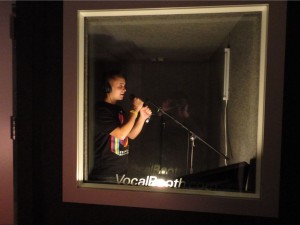When the Blu-ray film ends, the projector goes blank and you and your friends get up from your padded theater seats, you’ll walk back out into … the Harold B. Lee Library.
Along with its nearly four million books, the Harold B. Lee Library has a variety of little-known services that can be grouped into four categories: things you can check out, places you can use, things you can access digitally, and people to help with research.
[wpbp_blocks set=”all” ids=”363817″]
Equipment for check-out
The Multimedia Lab in the Media Center will lend out video camcorders, GoPro cameras, tripods, wireless microphone systems, digital SLR cameras and digital drawing tablets, among other things. Patrons can check equipment out for a three-day period after signing a loan agreement that is good for one year.
There’s no requirement to have experience with the equipment or be in a certain major to use Multimedia Lab resources. Head of the Media Center, Cyndee Frazier, said the center intentionally avoided acquiring really fancy equipment so it could encourage amateurs to check things out.
“We think (the Media Center is) something really cool that students should know about,” Frazier said. “We want them to use it.”
The Media Center also has a film collection based on faculty requests. Patrons can check out films for periods of three days or four hours, depending on the title.
The Harold B. Lee Library front desk offers iPads for week-long check out, but they are popular and cannot be reserved so students need to get there fast when one comes in, according to Rodger Layton, a Lee Library administrator.
The Science and Maps Desk offers four-hour checkouts of graphing calculators, AA batteries, flatbed scanners and GPS units (geocaching, anybody?)
Places to go
The newly renovated HD viewing room in the Media Center is just one of many comfortable spaces to watch a movie. There are other viewing rooms there, as well as an open viewing room in the back of the main area that includes a plasma screen monitor, comfy chairs and wireless headphones. Reservations can be made online.

Patrons can also reserve the Media Center sound booth, which can be used for recording or composing. People usually come in groups of at least two so one can run the software while the other performs, according to Frazier, who added that some students have used the booth to record an audition CD.
The Media Center also has equipment that will convert media from old formats to a CD or DVD.
Artists may be interested to know that the Science and Map section of the Harold B. Lee Library should have its new wide-format scanner by April 1. It will be able to process media up to 61.8 inches wide, scanning 56 inches of it. Jed Johnston, who is in charge of the map section resource desk, hopes the scanner will also be able to process thicker works than current library scanners can handle, including oil paintings. This scanner will also render colors better than do current library scanners.
“This new scanner will use LED technology, so color representation will be very accurate,” Johnston said. “(With traditional fluorescent bulbs), if you want accurate colors you have to wait until the bulb is all the way warmed up and you have to frequently calibrate it, which no one does.”
Digital services
The library has access to hundreds of online databases and journals. But it also has some resources with everyday uses.
For example, patrons can get subscriber access to the New York Times website if they ask a librarian about login credentials.
The Juvenile section of the library recently launched a website for “The Children’s Book and Play Review,” a service aimed at helping adults find quality literature to share with kids.
And of course digital services that are available campus-wide are also accessible on library computers. Ancestry.com offers subscriber access to campus computers because of an agreement with the Harold B. Lee Library. Adobe Master Collection CS5.5 is also available on most computers, though it may not appear on the desktop. This collection includes Photoshop, InDesign, Illustrator and other programs.
Sound and video editing software is available for use in the Multimedia Lab in the Media Center. Garageband, Soundtrack Pro and Audacity are all available for sound projects. Final Cut Pro 7 & 10, Adobe After Effects 6.5, Motion, LiveType and iMovie HD are available for film projects. Some students use these resources to build a portfolio and apply to related majors, according to Frazier.
The Multimedia Lab also offers free training classes to patrons who want to learn audio and video editing, graphic design, web design or other digital skills.
People to help with research
The Harold B. Lee Library employs highly-qualified subject librarians who usually have a Ph.D. or two masters degrees in their subject, according to Julie Williamsen, the Media Arts, Theatre and Communications subject librarian. If a patron clicks on a subject guide listed on the HBLL homepage, the name of the corresponding librarian will be displayed on the side of the guide, with a picture and contact information. Williamsen recently helped a student research how parents are portrayed in film and television.
“We looked at databases to find peer-reviewed articles and looked at books and reference material for background information,” Williamsen said.
She recommends that students check first with a reference desk for help, and if that doesn’t work, she is there to provide more in-depth help.
“I am here to help students and faculty with their research … in one-on-one appointments or by email,” Williamsen said. “And even nowadays I’m texting people, but not a lot.”




